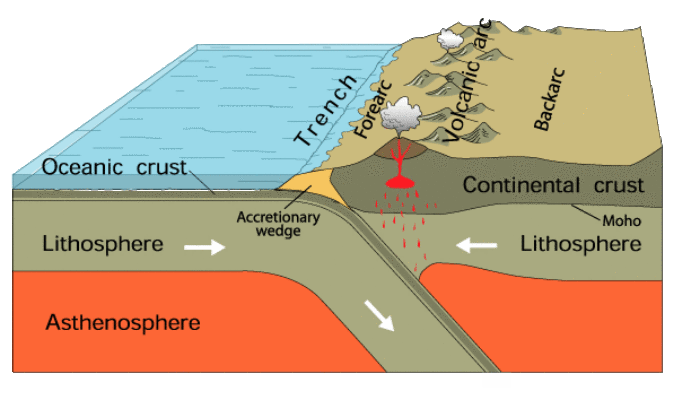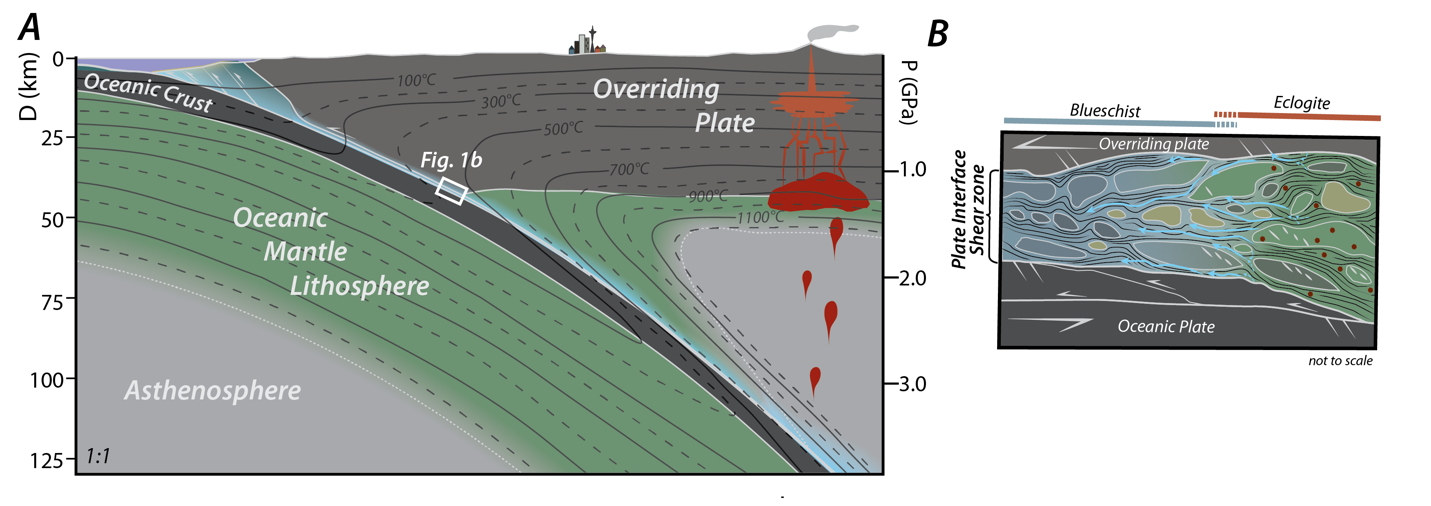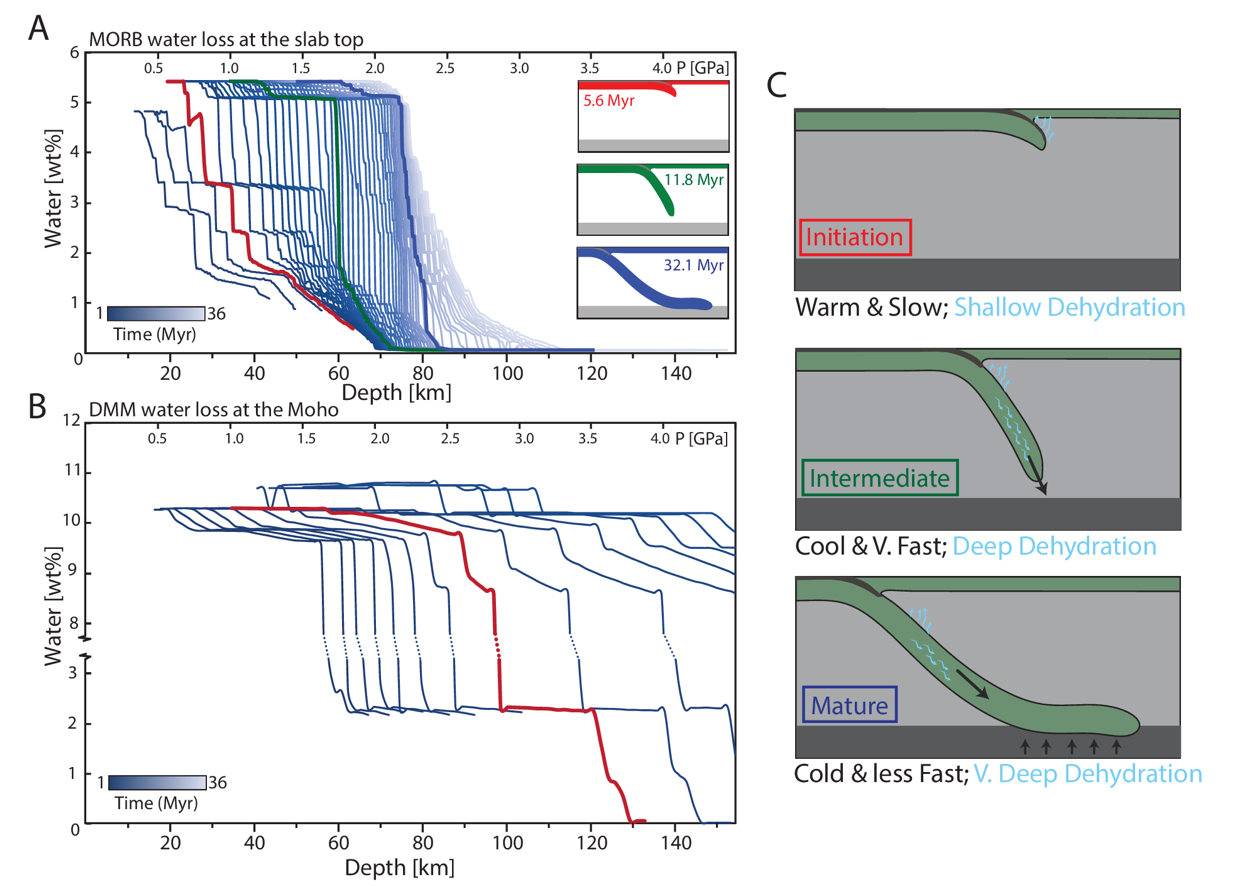
Subduction zones are as complex as they are ubiquitous. To understand subduction zone dynamics and processes we first have to understand the thermal structure of subduction zones and how this evolves in time. This week Adam Holt, Assistant Professor in the Department of Marine Geosciences (MGS) at the University of Miami Rosenstiel School of Marine and Atmospheric Science (RSMAS) and Cailey Condit, Assistant Professor in the Department of Earth and Spaces Sciences at the University of Washington, share their recent work on the slab thermal structure, its spatio-temporal variation and what this means for mantle hydration.

Adam Holt, Assistant Prof. at the University of Miami
The thermal structure of subduction zones affects an exceptionally wide range of subduction processes and properties. These include the rheological strength of the plate interface, mantle wedge melting, and the metamorphic phase transformations that occur in the downgoing plate (Figure 1). Via these temperature (and pressure) dependent transformations (e.g., blueschist to eclogite transition [Figure 1]), thermal structure contributes to element cycling by controlling when and where specific materials in the slab devolatilize (e.g., dehydrate) into the mantle wedge vs. where mineral-bound water remains in the slab and is dragged deep into the mantle. Developing a robust understanding of subduction zone thermal structure has therefore been a longstanding theme of subduction zone research (e.g., McKenzie, 1970; Davies, 1999; Syracuse et al., 2010).

Cailey Condit, Assistant Prof. at the University of Washington
In our recent work (Holt and Condit, 2021), we use subduction models to address the following two questions: How does slab thermal structure evolve over geological time? What are the dynamic processes that control this evolution? We compare time-dependent thermal models to pressure-temperature [P-T] conditions from exhumed rocks, and also use them to calculate time-evolving dehydration patterns in subducting slabs. Constraining this time-dependence is vital to interpret observables from the geological past (e.g., exhumed rocks) and to figure out how to time-integrate the processes that impact solid earth evolution (e.g., volatile fluxes into/out of the mantle).
Modelling studies often predict the thermal structure of Earth’s present-day subduction zones using numerical calculations of mantle wedge flow. These models typically prescribe constant subducting plate properties – it’s age, geometry, and speed – and calculate the resulting slab/wedge thermal structure. These kinematically-driven thermal models have led to important insights about how down-going water flux varies between subduction zones (e.g., Peacock, 1993; van Keken et al., 2011), what drives mantle wedge melting (Grove et al., 2009; Perrin et al., 2018), and rock exhumation (Gerya et al., 2002; van Keken et al., 2018). One of the main strengths of this approach is that such models are easy to tailor to a specific, present-day subduction zone, as speeds, geometries, and ages are well-known. However, due to a lack of dynamic consistency (i.e., slabs imposed rather than emergent), applying these models to study time-dependent phenomena is challenging.

Figure 1: Schematic illustration of subduction zone thermal structure (A) and the geological processes it impacts, including metamorphism and dehydration (B).
Rocks exhumed at paleo-subduction zones can indeed record highly time-dependent slab temperatures (e.g., Lázaro et al., 2009; Groppo et al., 2009); as is unsurprising given the relatively rapid, few-Myr-timescale, variability in subduction properties (e.g., convergence rates) recorded by tectonic observables and emergent in dynamic subduction models (e.g., Sdrolias and Müller et al., 2006; Cerpa et al., 2014). With this in mind, we used numerical models to develop a time-evolving framework for how slab temperature varies over a subduction zone’s lifetime. Relatively few studies have examined the detailed evolution of slab P–T conditions in dynamic models that do not impose any external forces or velocities on the slab-mantle system. Notably, Kincaid and Sacks (1997) showed that slab-top P-T conditions (i.e. the temperature along the upper surface of the slab) evolve significantly during subduction, with a pronounced cooling trend. We used the ASPECT finite element code (Bangerth et al., 2020; Kronbichler et al., 2012; Heister et al., 2017) to push this modelling approach further: We allowed slabs to evolve in a large model domain and interact with the lower mantle, highly resolved the plate interface region, and explored the effects of variable slab and crust properties (Figure 2a).

Figure 2: A) Thermal evolution of a time-dependent subduction model and a snapshot of the whole-model viscosity field. B-C) Time dependent temperature profiles along the slab top and slab Moho. Also on B: Agard et al’s (2018) exhumed rock P-T compilation.
Our slabs also experience highly time-dependent thermal conditions over their ~ 40 Myr model lifetimes. Slab temperatures decrease rapidly during subduction initiation – here, the first 5 to 10 Myr – and subsequently cool at a reduced rate. After initiation, this cooling is primarily in response to an ageing (and hence thickening) upper plate that blankets the slab; An effect that requires dynamic, time-evolving models to resolve. Superimposed on this are additional trends that are best seen in model P-T paths: depth-dependent temperature profiles along the slab top and slab Moho. For example, the slab Moho is coolest during the middle of the model run, as shown by the green P-T profile, before returning to warmer conditions (Figure 2c). This is because the most rapid convergence rates occur as the slab-tip sinks through the upper mantle during this intermediate phase, and so the internal part of the slab has less time to heat up as it sinks. Slab top profiles are less variable, besides cooling, but the P-T profiles gradually become more kinked (Figure 2b).
To summarise our thermal models: slab temperatures (both at the slab top and slab Moho) are highly dynamic and time-dependent! This suggests that subduction zone thermal structure at any snapshot is an integration of its time-dependent thermal evolution up to that point.
Such rapidly changing slab temperatures affect a host of important geological processes. For example, petrologic analyses of exhumed metamorphic rocks are a key constraint on slab P-T conditions and subduction related processes (see points on Figure 2b; Agard et al. 2018). However, most ancient subduction terranes were exhumed tens-to-hundreds of Myr ago at paleo-subduction zones. Our models demonstrate that – even at a single subduction zone – the recorded P-T conditions can vary by hundreds of degrees and sweep through much of the P-T conditions found in the rock record. This illustrates the importance of time dependance on thermal structure and can help researchers place exhumed rocks into their relevant geodynamic context. Moreover, this time dependance may help explain some of the discrepancies between modelled and observed slab temperatures (in addition to other mechanisms like shear heating, e.g., Penniston-Dorland et al. 2015; Kohn et al., 2018).
Next, to predict how slab dehydration evolves during subduction we also coupled our thermal models with thermodynamic phase equilibria modelling (done in the program Perple_X (Connolley and Petrini (2002)). Our P-T paths were fed into thermodynamic models of hydrated mid-ocean ridge basalt (MORB) and depleted MORB mantle (DMM; hydrated peridotite) to compute approximate dehydration depths and magnitudes along, respectively, the subduction interface and slab mantle. We found that during the initiation stages of subduction, when things are hottest, hydrated slab mantle provides most of the water that reaches sub arc depths (80-100 km) while it is so hot along the slab top that MORB loses all its water to dehydration reactions in the shallow forearc (Figure 3a-b). As the subduction zone cools down, MORB at the slab top becomes the dominant fluid source to the subarc mantle wedge, while hydrated DMM can carry ample water deep into the mantle far beyond the subarc because it remains refrigerated. While these patterns have been observed before, mainly in kinematically-driven models (e.g., Rüpke et al., 2004; Hacker et al., 2008; van Keken et al., 2011), our results highlight the importance of time evolving thermal structure on slab dehydration (Figure 3c).

Figure 3: Predicted slab dehydration. Dehydration during subduction shown as mineral bound water as a function of depth/pressure: A) the slab top (MORB composition), B) the slab Moho (DMM composition), C) schematic summary.
This work provides a basis for interpreting geologic observations that suggest subduction zone thermal structure is time-evolving, and points to several avenues for important future research. While our models provide example thermal evolutions, a key challenge is developing methodologies to attach these dynamic models to specific, time-evolving Earth subduction zones. In addition, many complexities that have been shown to affect thermal structure in kinematically-driven models – e.g., shear heating, three-dimensionality, melt and fluid migration – are understudied (or unstudied) within fully-dynamic models. These should produce interesting feedbacks between slab P-T (e.g., increases in temperature cause shallower slab dehydration/densification) and dynamics (e.g., shallower densification may speed subduction up and, in turn, cause cooling). Careful integration of geodynamic models and detailed geological observations will be needed to constrain these feedbacks!
References: Agard, P., Plunder, A., Angiboust, S., Bonnet, G., Ruh, J., (2018). The subduction plate interface: rock record and mechanical coupling (from long to short timescales). Lithos, 320–321, 537–566. https://doi.org/10.1016/j.lithos.2018.09.029 Bangerth W., Dannberg, J., Gassmoeller, R., Heister., T., (2020a). ASPECT v2.1.0. (version v2.1.0). Zenodo. https://doi.org/10.5281/ZENODO.3924604. Cerpa, N.G., Hassani, R., Gerbault, M., Prévost, J.H., (2014). A fictitious domain method for lithosphere-asthenosphere interaction: Application to periodic slab folding in the upper mantle. Geochemistry, Geophysics, Geosystems, 15, 1852-1877, https://doi.org/10.1002/2014GC005241 Connolly, J.A.D., Petrini, K., (2002). An automated strategy for calculation of phase diagram sections and retrieval of rock properties as a function of physical conditions. Journal of Metamorphic Geology, 20, 697-708, https://doi.org/10.1046/j.1525-1314.2002.00398.x Davies, J.H., (1999). Simple analytic model for subduction zone thermal structure. Geophysical Journal International, 139(3), 823-828, https://doi.org/10.1046/j.1365-246x.1999.00991.x Gerya, T. V., Stöckhert, B., Perchuk, A.L., (2002). Exhumation of high-pressure metamorphic rocks in a subduction channel: A numerical simulation. Tectonics, 21(6), https://doi.org/10.1029/2002tc001406 Groppo, C., Beltrando, M., Compagnoni, R., (2009). The P–T path of the ultra‐high pressure Lago Di Cignana and adjoining high‐pressure meta‐ophiolitic units: insights into the evolution of the subducting Tethyan slab. Journal of Metamorphic Geology, 27(3), 207-231. https://doi.org/10.1111/j.1525-1314.2009.00814.x Grove, T.L., Till, C.B., Lev, E., Chatterjee, N., Médard, E., (2009). Kinematic variables and water transport control the formation and location of arc volcanoes. Nature, 459, 694-697, https://doi.org/10.1038/nature08044 Hacker, B.R., (2008). H2O subduction beyond arcs. Geochemistry, Geophysics, Geosystems, 9, Q03001, https://doi.org/10.1029/2007GC001707 Heister, T., Dannberg, J., Gassmöller, R., Bangerth, W., (2017). High accuracy mantle convection simulation through modern numerical methods - II: Realistic models and problems. Geophysical Journal International, 210(2), 833-851, https://doi.org/10.1093/gji/ggx195 Holt, A. F., Condit, C. B., (2021). Slab temperature evolution over the lifetime of a subduction zone. Geochemistry, Geophysics, Geosystems, 22(6), https://doi.org/10.1029/2020GC009476 Kincaid, C., Sacks, I.S., (1997). Thermal and dynamical evolution of the upper mantle in subduction zones. Journal of Geophysical Research Solid Earth, 102, 12295–12315, https://doi.org/10.1029/96jb03553 Kronbichler, M., Heister, T., Bangerth, W., (2012). High accuracy mantle convection simulation through modern numerical methods. Geophysical Journal International, 191(1), 12-29, https://doi.org/10.1111/j.1365-246X.2012.05609.x Lázaro, C., García-Casco, A., Agramonte Y.R., Kröner A., Neubauer F., Iturralde-Vinent, M.A., (2009). Fifty-five-million-year history of oceanic subduction and exhumation at the northern edge of the Caribbean plate (Sierra del Convento melange, Cuba), Journal of Metamorphic Geology, 27,19–40, https://doi.org/10.1111/j.1525-1314.2008.00800.x McKenzie, D. P., (1970). Temperature and potential temperature beneath island arcs. Tectonophysics, 10(1–3), 357–366, https://doi.org/10.1016/0040-1951(70)90115-0 Peacock, S., (1993). Large-scale hydration of the lithosphere above subducting slabs. Chemical Geology, 108, 49-59, https://doi.org/10.1016/0009-2541(93)90317-C Perrin, A., Goes, S., Prytulak, J., Rondenay, S., Davies, D.R., (2018). Mantle wedge temperatures and their potential relation to volcanic arc location. Earth and Planetary Science Letters, 501, 67–77. https://doi.org/10.1016/j.epsl.2018.08.011 Sdrolias, M., Müller, R.D., (2006). Controls on back-arc basin formation. Geochemistry, Geophysics, Geosystems, 7(4), Q04016, https://doi.org/10.1029/2005GC001090 Syracuse, E.M., van Keken, P.E., Abers, G.A., (2010). The global range of subduction zone thermal models. Physics of the Earth and Planetary Interiors, 183, 73–90. https://doi.org/10.1016/j.pepi.2010.02.004 Rüpke, L.H., Morgan, J.P., Hort, M., Connolly, J.A.D., (2004). Serpentine and the subduction zone water cycle. Earth and Planetary Science Letters, 223(1-2), 17-34, https://doi.org/10.1016/j.epsl.2004.04.018 van Keken, P.E., Hacker, B.R., Syracuse, E.M., Abers, G.A., (2011). Subduction factory: 4. Depth-dependent flux of H2O from subducting slabs worldwide. Journal of Geophysical Research Solid Earth, 116, B01401, https://doi.org/10.1029/2010JB007922 van Keken, P.E., Wada, I., Abers, G.A., Hacker, B.R., Wang, K., (2018). Mafic High-Pressure Rocks Are Preferentially Exhumed From Warm Subduction Settings. Geochemistry, Geophysics, Geosystems, 19, 2934–2961. https://doi.org/10.1029/2018GC007624
